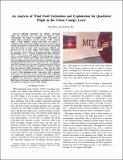| dc.contributor.author | Ware, John W. | |
| dc.contributor.author | Roy, Nicholas | |
| dc.date.accessioned | 2016-12-05T21:59:48Z | |
| dc.date.available | 2016-12-05T21:59:48Z | |
| dc.date.issued | 2016-05 | |
| dc.identifier.isbn | 978-1-4673-8026-3 | |
| dc.identifier.uri | http://hdl.handle.net/1721.1/105726 | |
| dc.description.abstract | Although unmanned air vehicles' increasing agility and autonomy may soon allow for flight in urban environments, the impact of complex urban wind fields on vehicle flight performance remains unclear. Unlike synoptic winds at high altitudes, urban wind fields are subject to turbulence generated by the buildings and terrain. The resulting spatial and temporal variation makes inference about the global wind field based on local wind measurements difficult and prevents the use of most simple wind models. Fortunately, the structure of the urban environment provides exploitable predictability given a suitable computational fluid dynamics solver, a representative 3D model of the environment, and an estimate of the expected prevailing wind speed and heading. The prevailing wind speed and direction at altitude and computational fluid dynamics solver can generate the corresponding wind field estimate over the map. By generating wind fields in this way, this work investigates a quadrotor's ability to exploit them for improved flight performance. Along with the wind field estimate, an empirically derived power consumption model is used to find minimum-energy trajectories with a planner both aware of and naive to the wind field. When compared to minimum-energy trajectories that do not incorporate wind conditions, the wind-aware trajectories demonstrate reduced flight times, total energy expenditures, and failures due to excess air speed for trajectories across MIT campus. | en_US |
| dc.language.iso | en_US | |
| dc.publisher | Institute of Electrical and Electronics Engineers (IEEE) | en_US |
| dc.relation.isversionof | http://dx.doi.org/10.1109/ICRA.2016.7487287 | en_US |
| dc.rights | Creative Commons Attribution-Noncommercial-Share Alike | en_US |
| dc.rights.uri | http://creativecommons.org/licenses/by-nc-sa/4.0/ | en_US |
| dc.source | MIT web domain | en_US |
| dc.title | An analysis of wind field estimation and exploitation for quadrotor flight in the urban canopy layer | en_US |
| dc.type | Article | en_US |
| dc.identifier.citation | Ware, John, and Nicholas Roy. “An Analysis of Wind Field Estimation and Exploitation for Quadrotor Flight in the Urban Canopy Layer.” IEEE, 2016. 1507–1514. | en_US |
| dc.contributor.department | Massachusetts Institute of Technology. Computer Science and Artificial Intelligence Laboratory | en_US |
| dc.contributor.department | Massachusetts Institute of Technology. Department of Aeronautics and Astronautics | en_US |
| dc.contributor.mitauthor | Ware, John W. | |
| dc.contributor.mitauthor | Roy, Nicholas | |
| dc.relation.journal | IEEE International Conference on Robotics and Automation, 2016 | en_US |
| dc.eprint.version | Author's final manuscript | en_US |
| dc.type.uri | http://purl.org/eprint/type/ConferencePaper | en_US |
| eprint.status | http://purl.org/eprint/status/NonPeerReviewed | en_US |
| dspace.orderedauthors | Ware, John; Roy, Nicholas | en_US |
| dspace.embargo.terms | N | en_US |
| dc.identifier.orcid | https://orcid.org/0000-0002-5867-4900 | |
| dc.identifier.orcid | https://orcid.org/0000-0002-8293-0492 | |
| mit.license | OPEN_ACCESS_POLICY | en_US |
| mit.metadata.status | Complete | |
